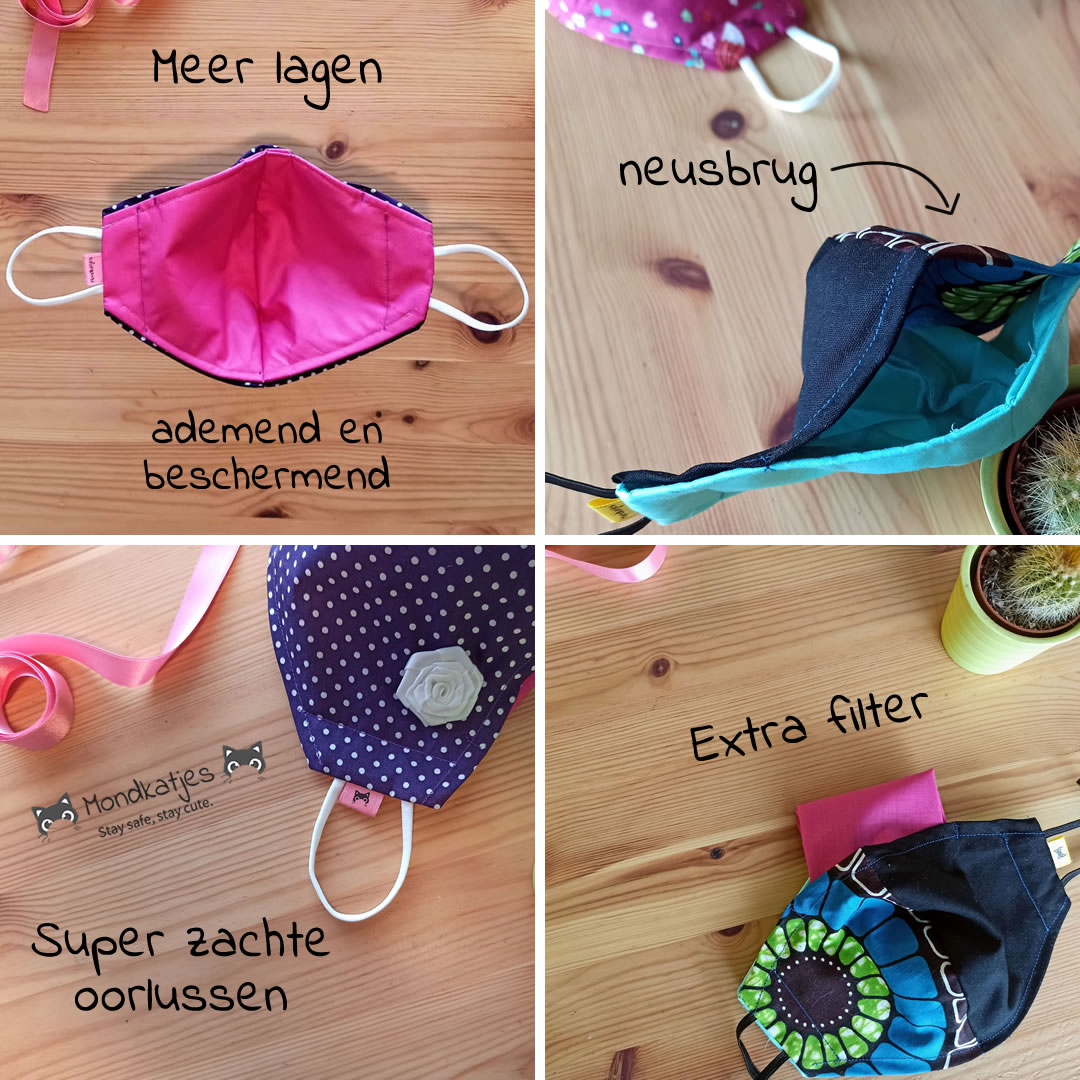Team Mondkatjes
Last updated on 30 December 2020
The 5 features you want in a fabric face mask
 Washable face masks by Mondkatjes. Our face masks come with four layers for a perfect balance between breathability and protection. View our collection
Washable face masks by Mondkatjes. Our face masks come with four layers for a perfect balance between breathability and protection. View our collection
With the worldwide COVID-19 outbreak revolutionizing our everyday lifestyle and new relevant regulations being introduced in many countries, wearing face masks has become a common practice to protect ourselves and others.
In The Netherlands, as per RIVM advice mouth masks are mandatory on all public transports as of 1st of June and need to be worn for the whole duration of the ride, which, for many, may result in feeling uncomfortable and not exactly good looking. Let’s be honest: Who wants to travel with a cloth (or worst, a diaper..) on their faces?
This is the reason why many people prefer to use fabric face masks rather than disposable ones, which are definitely less appealing when it comes to comfort and looks. But how can you be sure that your fabric face mask is also effective? Which fabric materials are the best? Is an extra filter needed? Do reusable and washable face masks provide enough protection?
We’ll try to answer these questions and outline what features you should expect from a protective face mask.
01
Check the filtration power
When we talk about the effectiveness of a mouth mask, it’s all about its filtration power. Handmade reusable face masks can grant a good level of protection, especially if they have multiple layers, and, depending on the specific fabric they’re made of, might even increase their efficiency with an extra filter.
As supported by several studies, cotton face masks that include an extra filter drastically improve their effectiveness. According to Dr. Joel Burken, Ph.D, chair of the department of civil, architectural and environmental engineering at Missouri University of Science and Technology, and Yang Wang, Ph.D, assistant professor of environmental engineering, light fabrics block only 10-20% of aerosol-sized particles, but if you add one or more layers of filter they can block up to 80-90%, "approaching (the rates) of N95 masks.”
This blog is offered by Mondkatjes. We make the best fabric face masks in the Netherlands. Our masks with filter are washable, durable, and stylish. Discover our trendy face masks collections.
Discover our trendy face masks collections.
02
Choose breathable fabric
When wearing a fabric face mask, especially if you need to keep it on for a considerable amount of time, you definitely want to make sure you can breathe and feel as least impairment as possible. Over the past months Dr Scott Segal, anesthesiologist at Wake Forest Baptist Health in Winston-Salem, North Carolina, has researched the effectiveness of different mask fabrics, suggesting preference should go to cotton and slightly thicker materials. To estimate whether a fabric mouth mask is made of a breathable yet efficient enough material, Dr. Segal advises to perform the "light test": hold it up to the light and if you can see its individual fibers, it means that it’s most likely not the best choice.
Again, in this case, you can highly benefit from adding a filter to your fabric face mask; otherwise, go for a mouth mask that includes a multilayer system.
03
Opt for a mask that fits your face
One common issue that many fabric face masks share is that they do not always perfectly fit the user’s face shape, resulting in being too large or too small, and losing, therefore most of their protective power. If you want to wear a cotton face mask it’s definitely better to choose one that includes a flexible nose strip that you can adjust so that the face mask adheres to your face.
We also suggest paying attention to the shape of the mask, since many reusable face masks are realized in a standard format that cannot obviously suit every face and risk to be too loose, neutralizing their protective function. fabric face masks with a more solid yet flexible structure guarantee more thorough adaptability and are therefore preferable.
Discover our trendy face masks collections.
04
Go for fabrics resistant to washing and ironing
The point of wearing a washable face mask is that it can be reused multiple times while still keeping its filtration power and breathability. It is very important that, after each use, you wash your face mask accurately, including it with the regular laundry (30° C) and using normal detergent and softener. Experts advise to always make sure that, once you wear it, the face mask is completely dry.
fabric face masks can also be ironed for extra sterilization; the ironing temperature may vary depending on the kind of fabric and on whether or not the face mask includes any extra filters.
05
Use elastic loops and bands that don’t cut your ears
Especially if you have to wear a cotton or reusable face mask for a long time, you surely do not want to feel your ears hurt after only a few minutes because the elastic loops are too tight. At the same time, in order to keep your face mask’s efficiency level at maximum, it’s vital that it is secured correctly- if it falls off because it feels too loose, there’s not much of a sense in wearing it, right?
That’s why you need to make sure the elastic ear loops are made of soft flexible materials and, if you want, add some extra bands or laces that can be tightened behind your head.